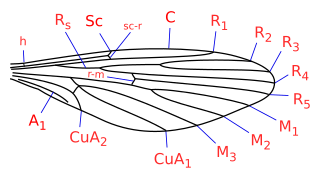
The Nematocera are a suborder of elongated flies with thin, segmented antennae and mostly aquatic larvae. This group is paraphyletic and contains all flies but species from suborder Brachycera, which includes more commonly known species as housefly or the common fruit fly. Families in Nematocera include mosquitoes, crane flies, gnats, black flies, and a multiple groups of families described as midges. The Nematocera typically have fairly long, fine, finely-jointed antennae. In many species, such as most mosquitoes, the female antennae are more or less threadlike, but the males have spectacularly plumose antennae.

Psychodidae, called drain flies, sink flies, filter flies, sewer flies, or sewer gnats, is a family of true flies. Some genera have short, hairy bodies and wings giving them a "furry" moth-like appearance, hence one of their common names, moth flies. Members of the sub-family Phlebotominae which are hematophagous may be called sand flies in some countries, although this term is also used for other unrelated flies.
The Nymphomyiidae are a family of tiny (2 mm) slender, delicate flies (Diptera). Larvae are found among aquatic mosses in small, rapid streams in northern regions of the world, including northeastern North America, Japan, the Himalayas, and eastern Russia. Around a dozen extant species are known, with two fossil species found in amber, extending back to the Mid Cretaceous. Under an alternative classification, they are considered the only living representatives of a separate, suborder called Archidiptera which includes several Triassic fossil members. The family has characteristics associated with the Nematocera as well as the Brachycera. The antennae are shortened as in the Brachycera and these flies are long, having a snout with vestigeal mouthparts, non-differentiated abdominal segments with large cerci. The wings are narrow and hair-fringed and have very weak venation. They are known to form cloud-like swarms in summer and the short-lived non-feeding adults have wings that fracture at the base shortly after mating.

The Phlebotominae are a subfamily of the family Psychodidae. In several countries, their common name is sandfly; but that name is also applied to other flies. The Phlebotominae include many genera of blood-feeding (hematophagous) flies, including the primary vectors of leishmaniasis, bartonellosis and pappataci fever. In the New World, leishmaniasis is spread by sand flies in the genus Lutzomyia, which commonly live in caves, where their main hosts are bats. In the Old World, sand flies in the genus Phlebotomus spread leishmaniasis.

The Psychodinae are the nominate subfamily of moth flies (Psychodidae), also known as drain flies. Like most of their relatives, they are usually found in damp habitats; some occur in caves. The small larvae are aquatic or semi-terrestrial; the adults are winged and capable of flight. Psychodinae are found worldwide, including some subantarctic islands.

Nemopalpus is a genus of moth fly in the family Psychodidae, in the subfamily Bruchomyiinae. Nemopalpus is sometimes spelled "Nemapalpus" and recently (2018) a number of similar species have been transferred to the genera: Alexanderia, Boreofairchildia, Laurenceomyia and Notofairchildia.
Maruina is a genus of moth flies in the family Psychodidae. There are at least 30 described species in Maruina. marui, diminutive for a fly.
Sycorax is a genus of moth flies and sand flies in the family Psychodidae. There are at least 40 described species in Sycorax.
Wiedemannia is a genus of flies in the family Empididae.
Chelifera is a genus of flies in the family Empididae.
Feuerborniella is a genus of flies belonging to the family Psychodidae.
Peripsychoda is a genus of flies belonging to the family Psychodidae.
Paramormia is a genus of flies belonging to the family Psychodidae.
Panimerus is a genus of flies belonging to the family Psychodidae.
Ulomyia is a genus of flies belonging to the family Psychodidae.
Boreofairchildia is a genus of moth flies in the subfamily Bruchomyiinae. Species have been recorded from the Americas, principally Central and South America, with many, including the type, transferred from the genus Nemopalpus.
Alexanderia is a genus of moth flies in the subfamily Bruchomyiinae. This genus circumscribes species from south-east Asia, with three including the type, transferred from the genus Nemopalpus.
Didicrum is a genus of the family Psychodidae and has a handful of species studied so far. The discovery of this genus in Colombia represents a significant range extension for Didicrum as all previously described species of this genus are distributed in the Australasian region and the southernmost portion of South America.





